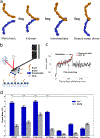Cadherins can dimerize via asymmetric interactions
- PMID: 35532156
- PMCID: PMC9829383
- DOI: 10.1002/1873-3468.14373
Cadherins can dimerize via asymmetric interactions
Abstract
Cadherins are essential cell-cell adhesion proteins that interact in two distinct conformations: X-dimers and strand-swap dimers. Both X-dimers and strand-swap dimers are thought to exclusively rely on symmetric sets of interactions between key amino acids on both cadherin binding partners. Here, we use single-molecule atomic force microscopy and computer simulations to show that symmetry in cadherin binding is dispensable and that cadherins can also interact in a novel conformation that asymmetrically incorporates key elements of both strand-swap dimers and X-dimers. Our results clarify the biophysical rules for cadherin binding and demonstrate that cadherins interact in a more diverse range of conformations than previously understood.
Keywords: AFM force measurements; X-dimer; classical cadherins; molecular dynamics; strand-swap dimer; trans interactions.
© 2022 Federation of European Biochemical Societies.
Conflict of interest statement
Figures



References
-
- Boggon TJ, Murray J, Chappuis-Flament S, Wong E, Gumbiner BM, Shapiro L. C-cadherin ectodomain structure and implications for cell adhesion mechanisms. Science. 2002;296(5571):1308–13. - PubMed
Publication types
MeSH terms
Substances
Grants and funding
LinkOut - more resources
Full Text Sources
Miscellaneous

